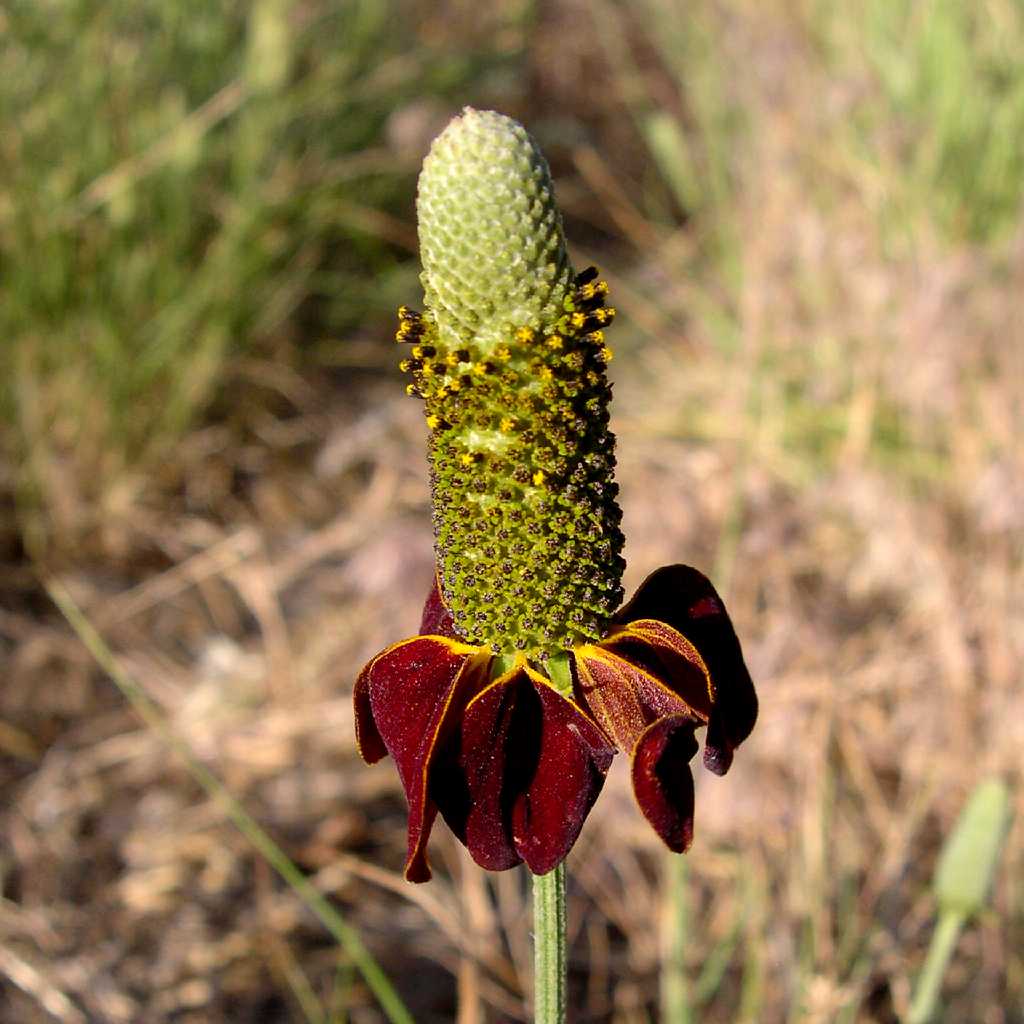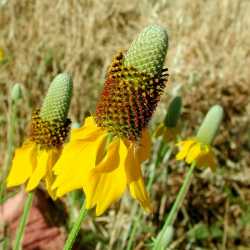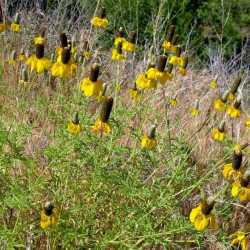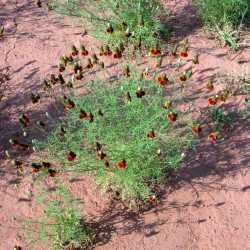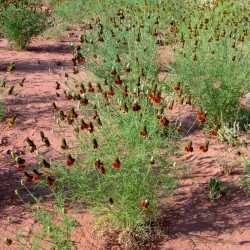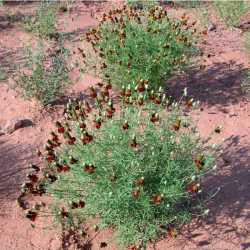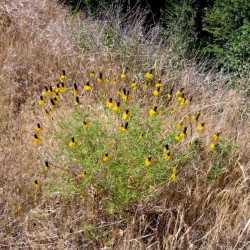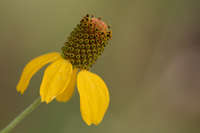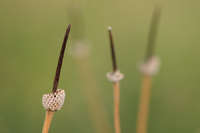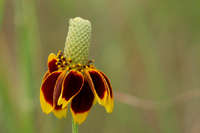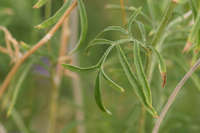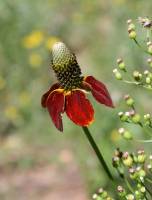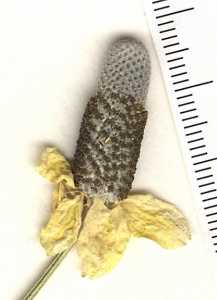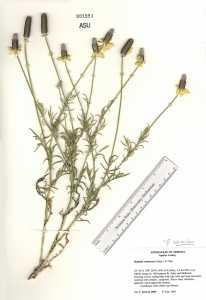|
|
|
|
Family: Asteraceae
upright prairie coneflower
[Lepachys columnaris (Sims) Torr. & A. Gray, moreLepachys columnifera Macbr., Ratibida columnaris (Sims) Rafin., Ratibida columnaris var. pulcherrima (DC.) D.Don, Rudbeckia columnaris Sims, Rudbeckia columnifera Nutt.] |
Perennials, to 105+ cm; taprooted. Leaves 2-15+ × 0.8-6 cm, 1-2-pinnatifid, lobes 3-14, narrowly linear-lanceolate to narrowly oblong-ovate, 1-16 mm wide, faces hirsute, gland-dotted. Heads 1-15, held well beyond leaves. Peduncles (1.5-)6.5-48+ cm (ribs tan, prominent). Phyllaries 5-14, outer linear, 4-14 × 0.5-2 mm, inner lanceolate-ovate, 0.8-3 × 0.8-2 mm. Paleae 2.3-3.5 × 0.5-3 mm, resin glands oval-oblanceolate, 0.6-1.5 mm. Ray florets 4-12; corollas yellow, purplish yellow, or maroon, sometimes bicolor (maroon/yellow), laminae lanceolate-ovate to elliptic-oblanceolate, 7-35 × 4-17 mm. Discs columnar, 10-50 × 7-12 mm. Disc florets 200-400+; corollas greenish yellow, often purplish distally, 1-2.5 mm; style branches 0.5-1.4 mm, proximal 2/3-3/4 stigmatic, apices rounded. Cypselae oblong, 1.2-3 × 1.2-2 mm, abaxial margins glabrous, adaxial margins and apices glabrous or ciliate; pappi (tan) usually of 1-2 toothlike projections, sometimes 0. 2n = 28. Flowering Mar-Nov. Prairies; 10-2200 m; Alta., B.C., Man., Ont., Sask.; Ariz., Ark., Colo., Ill., Ind., Iowa, Kans., La., Mass., Minn., Mo., Mont., Nebr., N.J., N.Mex., N.C., N.Dak., Okla., S.Dak., Tenn., Tex., Utah, Wis., Wyo.; Mexico (Chihuahua, Coahuila, Hidalgo, Nuevo León, San Luis Potosí, Tamaulipas, Veracruz). Ratibida columnifera is grown as an ornamental and is often included in wild flower plantings. Such activities may extend the geographic range of the species to roadsides and prairie-like habitats. Some variants of Ratibida columnifera have been treated as varieties or forms. The most prominent of these is forma pulcherrima (de Candolle) Fernald, which is characterized by its showy, purplish yellow to purple rays; it is more frequent in the southwestern part of the range of the species. In the typical form, rays are yellow (E. L. Richards 1968). Some authors have argued that Ratibida columnaris (Sims) D. Don is the correct name for this species; J. L. Reveal (1968) and E. L. Richards (1968) provided synoptic discussions of the issue.
Taprooted, with clustered stems 3-12 dm, strigose or partly hirsute, generally leafy to above the middle; lvs pinnatifid or partly bipinnatifid, the ultimate segments linear or lanceolate, entire or nearly so, relatively few and often very unequal, generally many of or all them 1.5 cm or more; heads (1-)several or many, naked-pedunculate, the disk columnar, 1.5-4.5 cm, 2-4.5 times as long as thick; rays yellow or (f. pulcherrima (DC.) Fernald) partly or wholly brown- purple, 1-3.5 cm, spreading or reflexed; style-appendages very short and blunt; achenes with the inner margin fringed-ciliate to nearly smooth, usually slightly winged; pappus an evident awn-tooth on the inner angle of the achene, and often also a shorter one on the other angle; 2n=26, 27, 28, 34-38. Prairies and other dry, open places; Minn. to Mo. and La., w. to Mont., Tex., and n. Mex., and occasionally intr. e. June-Aug. Taprooted, with clustered stems 3-12 dm, strigose or partly hirsute, generally leafy to above the middle; lvs pinnatifid or partly bipinnatifid, the ultimate segments linear or lanceolate, entire or nearly so, relatively few and often very unequal, generally many of or all them 1.5 cm or more; heads (1-)several or many, naked-pedunculate, the disk columnar, 1.5-4.5 cm, 2-4.5 times as long as thick; rays yellow or (f. pulcherrima (DC.) Fernald) partly or wholly brown- purple, 1-3.5 cm, spreading or reflexed; style-appendages very short and blunt; achenes with the inner margin fringed-ciliate to nearly smooth, usually slightly winged; pappus an evident awn-tooth on the inner angle of the achene, and often also a shorter one on the other angle; 2n=26, 27, 28, 34-38. Prairies and other dry, open places; Minn. to Mo. and La., w. to Mont., Tex., and n. Mex., and occasionally intr. e. June-Aug. Gleason, Henry A. & Cronquist, Arthur J. 1991. Manual of vascular plants of northeastern United States and adjacent Canada. lxxv + 910 pp. ©The New York Botanical Garden. All rights reserved. Used by permission. FNA 2006, Martin and Hutchins 1980; Allred and Ivey 2012, Heil et al. 2013 Duration: Perennial Nativity: Native Lifeform: Forb/Herb General: Perennial herbs, 20-100 cm tall, from a taproot; stems erect, hirsute-strigose and glandular. Leaves: Basal leaves petiolate, often withering at maturity; stem leaves alternate, often sessile; blades 2-15 cm long to 1-6 cm wide, pinnately lobed with 3-14 lobes, the lobes oblanceolate to linear, 1-16 mm wide, the faces hirsute, gland-dotted. Flowers: Flower heads showy, radiate with yellow to maroon rays and tall columnar receptacles; flower heads held well above the leaves on long leafless peduncles, 6-40 cm long, with prominent tan ribs; involucres spreading-campanulate to rotate, 1 cm wide, the bracts (phyllaries) 2 series, outer ones linear, 4-14 mm long, inner ones lanceolate-ovate, 1-3 mm long; ray florets 4-12 per flower head, the laminae (ray petals) yellow, purplish-yellow, maroon, or bicolored, lanceolate-ovate to elliptic-oblanceolate, 1-3 cm long and 4-17 mm wide; receptacles columnar, 1-5 cm tall and about 1 cm wide; disc florets 200-400 per flower head, covering the columnar receptacle, the corollas greenish yellow, often purplish below; palea subtending the disc florets white-pubescent, making the disc florets appear greenish gray before they open. Fruits: Achenes oblong, 1-3 mm long, the upper margins and apices sometimes ciliate; sometimes topped with a pappus of 1-2 tan-colored toothlike projections. Ecology: Found in pinyon-juniper and ponderosa pine woodlands, prairies, grasslands, and disturbed areas, from 4,000-7,500 ft (1219-2286 m); flowers March-November. Distribution: s CAN, south primarily through the Great Plains to n MEX Notes: This perennial herb is distinctive with its columnar flower head and colorful, sometimes bicolored, ray petals. Plants with predominantly purple or maroon rays have been treated as forma pulcherrima. Included in many wildflower mixes, this species is now interoduced widely outside its native range. Ethnobotany: Used to wean children off breast milk, and medicinally to treat pain, poison ivy rash, snake bites, chest pains, wounds, stomachaches, coughs, and fever; also used ceremonially. Etymology: The derivation of the genus name Ratibida is unknown; columnifera refers to the tall cylindrical flower heads. Synonyms: Lepachys columnifera, Ratibida columnaris, Rudbeckia columnaris, R. columnifera Editor: SBuckley 2010, AHazelton 20017 |
|
|
|


